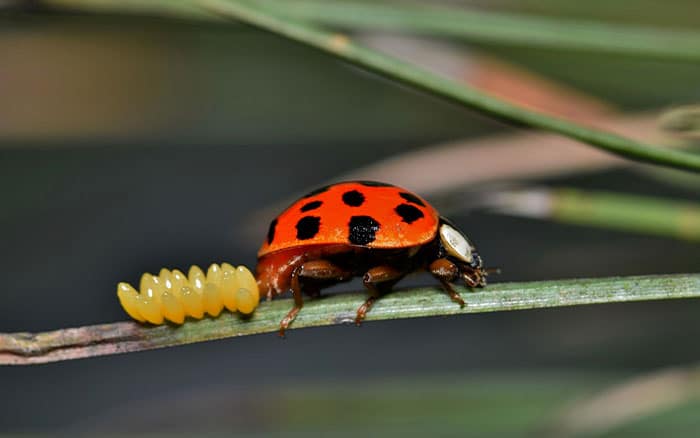Ladybirds, or ladybugs, are a type of beetle. There are more than 40 species in Britain. Interestingly, approximately 20 of these species are smaller than 3mm and dark in colour compared to the image of ladybird that’s conjured up when we think of them. For this reason, they’re not often recognised as ladybirds.
Ladybird species
The harlequin ladybird which may be one of the most commonly seen in Britain. However, it is an introduced species that was established in Britain in 2004. They are either black with two red spots or orange with 18 black spots. This species originates in Asia, and as well as the UK, it was introduced to North America. In North America it’s also referred to as ‘Halloween bug’. This is because large numbers of the species gather together in autumn.
Another common species is the 7-spot ladybird which has black on red markings. About 6-8mm in length, they are easily recognised by their dotted wings. This species also has a black and white thorax.

What do they look like?
Depending on the types, ladybirds’ lengths range from 1-10mm.
When we think of ladybirds, we think of red, orange, and sometimes yellow creatures with black spots. But the colours aren’t just to make them stand out. They are actually a warning to predators that they aren’t worth eating because they have an unpleasant taste. Birds are their main predators, however frogs, spiders, wasps, and dragonflies are also among the wildlife that like to feast on them.
In addition, it’s not only their colouring that they use to deter predators. Their other defence mechanism is their ability to secrete a yellow, pungent substance.
Life cycle
During the months from October to February, adult ladybirds spend winter in a dormant state called ‘overwintering’.
The, come March and April the adult ladybirds awaken and become active. They leave their hibernation hubs in search of food.
At this time, male and female ladybirds mate and subsequently lay eggs. Those predatory species that feast on aphids cleverly lay the eggs of plants that have colonies of aphids or other insects they prey on. This way, when the eggs hatch, there is plenty of food for the larvae. For those species that eat fungi as part of their diet – like the orange ladybird and the 22-spot ladybird – the adults lay the eggs on plants that have been affected by mildew.
The larvae pass through four stages, eventually forming pupae. Then, the new generations emerge from the pupae as adults.
From here, the adults feed, overwinter, and then mate the following spring. The lifecycle then repeats. This lifecycle is generally relevant for species that only breed one generation a year. However, bear in mind that some species do have more than one generation per year, in these cases, the timings of the lifecycle will differ.

What do they eat?
Most prey on aphids and insects which makes them fantastic bouncers, so it’s well worth attracting ladybirds to your space. Aphids are common garden pests that can attack crops in your grow-your-own area.
Some ladybirds eat fungi or plants, however these are generally less common. Don’t worry though, these aren’t likely to damage your plants either.
In its year-long life, one seven-spot ladybird can eat more than 5,000 aphids.

What plants do ladybirds like?
Choosing plants to encourage garden bouncers is ideal.
The bright colour of marigolds are great for ladybirds and the nectar rich flowers are another selling point.
In a similar way, the bright tasty blooms and foliage of nasturtiums are attractive to both aphids and ladybirds. This means the aphids flock to them – keeping your crops safe – whilst giving ladybirds a guaranteed meal too.
Growing dill is a win-win. Not only do you get the leafy herb to add to your dishes in the kitchen, but pollinators and ladybirds will love it too. Grow it among your grow-your-own area where it will also repel tomato hornworms.

How to attract them to your garden
They live in shrubland, grasslands, forests and along rivers.
During wintertime the adults hibernate. They hibernate in leaf litter, or cracks and crevices in their habitats. Then, come April, they emerge to find a mate to reproduce with.
Therefore, it’s ideal to have piles of leaves, branches, or logs to attract these creatures.
Alternatively, attract ladybirds to your garden and give them a warm welcome by building a bug hotel or a ladybird hotel from pinecones.
You will need:
- Pinecones
- Chicken wire
- Scissors
- String
STEP ONE
Cut a length of chicken wire 50-80cm long.
STEP TWO
Make a pile of pinecones in the middle and lift up the edges to make a bag around them.
STEP THREE
Fold in or cut out the excess.
STEP FOUR
Tie the top of the bag together with string and hang the hotel in a sheltered spot in the garden.
Press the pinecones into one another so the scales link and hold together. You can also tie them together with string.


Leave A Comment